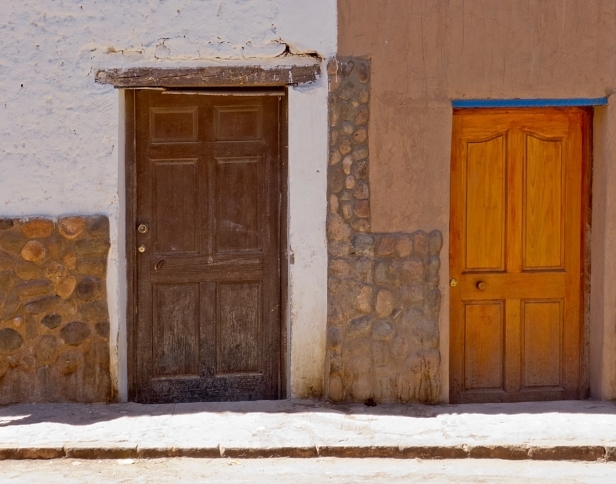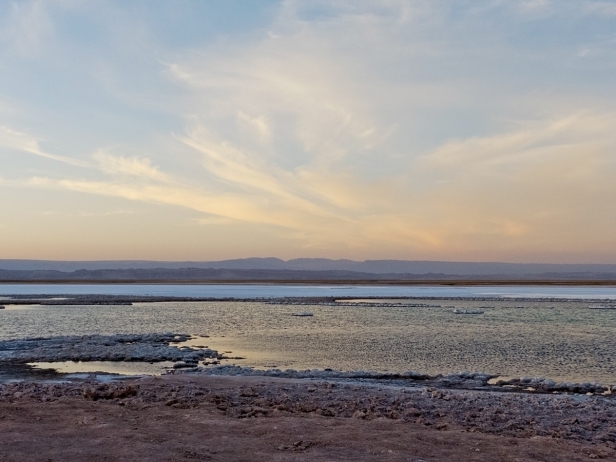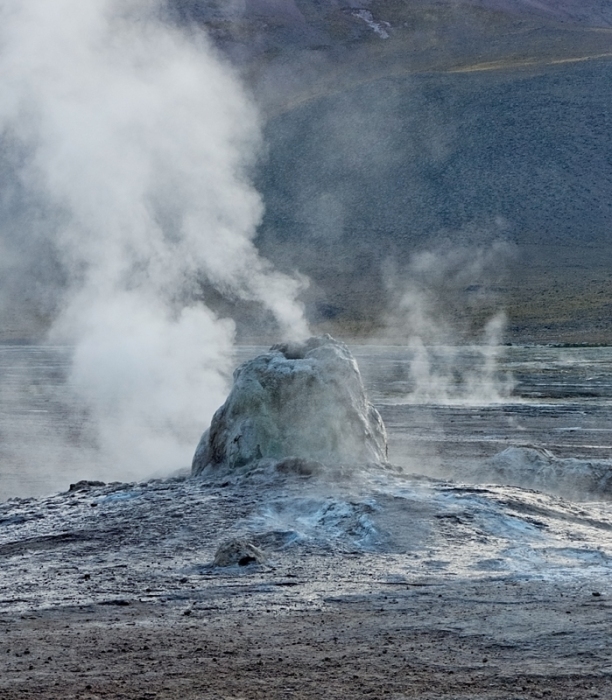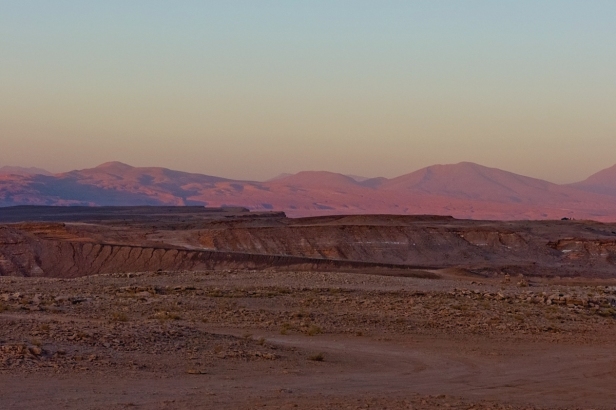14-19 December 2013. Once again we boarded one of Chile’s luxurious double-decker buses, took our seats in the upstairs front row, and journeyed east from Antofagasta to San Pedro de Atacama. We thought the scenery of the Atacama Desert had been pretty spectacular so far, but we discovered it was just beginning.
But first this:
It’s a roadside shrine. We saw them frequently in Argentina, and then again in Chile as we travelled from Santiago north to Antofagasta, but they seemed to increase exponentially the further north we got. Dozens of them, hundreds probably, seemingly one about every half kilometer. They are all shapes and sizes, from a simple small cross, to a small wooden “house” about 12 inches high, to quite large structures. What they all have in common are crosses, all kinds of “bricabrac” that presumably has some meaning for the dead, and are open to, and face the road. A variety of different materials are used – wooden buildings, old tires as seen above, painted rocks to outline a pathway, tiled structures, flags, some had bushes (though I have no idea how they survive in the desert), some had the name of the person who had died, one had the message Adios hasta siempre Marcello, and one was so large it contained a car mounted on a platform. If ever the desert scenery became monotonous, which it didn’t, there was always the endless and varied array of shrines to attract our attention.
San Pedro de Atacama is a small oasis desert town and a tourist mecca for arriving from, or heading to, the altiplano, and salt flats, of Bolivia, and for day tours in the area to some truly dazzling scenery. It’s just a desert, but unlike any desert you could imagine. We were constantly moved by its beauty.
San Pedro seems to be divided into two sections. One section is beautifully preserved in the original mud brick and whitewash style, and houses everything a tourist could wish for – hotels, hostels, tour companies, local craft stores, restaurants, cafes, bars, and convenience stores. It’s beautiful.


There is another San Pedro for the local population of about 5000, which, from the brief glimpse we saw of it, is not so pretty, however I imagine the endless tourist dollars make this a relatively prosperous place. I don’t think I’ve ever seen a place where there’s such a distinct division between the ordinary town and the facilities for tourists. We usually go walking all over the place, and I’m sure we would have discovered that other San Pedro, but because of the altitude we were not feeling very energetic.
San Pedro, at 2400 metres, was our first introduction to altitude. We planned five days there to give us some time to adjust. Our constant cry was more red blood cells, more red blood cells! When we’re usually so fit it’s not fun to be gasping after climbing a flight of stairs, and to have mild headaches, mild nausea, and sleepless nights. All this did not deter us however. There was too much to see in this incredible part of the world.
Our first excursion was to the Salar de Atacama (salt flats of Atacama) where we swam, or I should say floated, in the extremely salty Lago Cejar.


This was followed by a quick visit to a freezing cold, extremely deep, fresh-water desert well to wash off the salt. We both declined, preferring the prickly salt on our skin to the freezing water. Finally we were taken to Lago Tebinquinche, which is less a lake than a large expanse of salt, covered in parts with a thin skim of water. This is what Don’s feet looked like after we’d walked all over it.
We stayed there for a sublime sunset, enchanted by the ethereal beauty of this strange landscape. We were also given Pisco Sours to drink which I’m sure helped increase our appreciation of the moment.


We got up at about three one morning, and were collected at a little after four to be taken to the literally breathtaking Geysers del Tatio at 4320 metres above sea level, an increase of almost 2000 metres in the space of a couple of hours. It was breathtaking in every sense. Tatio means grandfather and it is one of the highest-elevation geyser fields in the world. If you think the earth is still, quiet, inert, solid, a geyser field will soon change your mind. Don and I went our separate ways wandering around watching and photographing the earth steaming and bubbling, hissing and spouting. It is far from still.


After sunrise looking away from the geyser field:
As long as we didn’t move too quickly we were fine. After a breakfast that included eggs boiled in one of the geyser spouts, we grabbed our daypacks and headed to the change rooms to have a soak in one of the hot pools. Don didn’t make it. Suddenly his heart went into tachycardia, and all he could do was sit. I went into a freezing cold change room, stripped down, changed into swimsuit, ran freezing and barefoot and climbed into a pool that was either too hot or too cold depending on where you sat. Out within five minutes, running freezing back to the change room and drying and dressing at lightening speed. Back to Don. He’s still in tachycardia but okay. In my freezing rushing, and taking care of Don, and carrying both daypacks, I managed to lose my flipflops. I’ve lost so many things on this trip – I seem to be shedding stuff everywhere I go.
On the way back to San Pedro we stopped at a small village for snacks. I think the village is mostly seasonal housing for shepherds.
I loved the juxtaposition of the Christmas tree, the mud and rock house, and the painted flamingo:
Most people went to look at the church and bought barbequed llama snacks. I walked off in the opposite direction and found a few llamas grazing in a field, and this:
and this – a couple of baby cormorants in a nearby river:
Back down to earth, relatively speaking, and back into the desert, a couple of days later we headed to Valle de la Luna and Valle de la Muerte (Moon Valley and Death Valley). We began with a little caving, entering through a narrow passageway in the rocks, scrambling half bent over in the dark for a short while, led by our fearless guide Marcelo,
and emerging here:
The Valle de la Luna and Valle de la Muerte area is one of the most visited parts of the Atacama, and of Chile. Here’s why:






Next post: Things got even more amazing, and breathtaking, as we travelled on a three day 4×4 tour from San Pedro de Atacama to Uyuni, Bolivia, climbing to 5000 metres. Three days we won’t ever forget.
All words and images by Alison Louise Armstrong unless otherwise noted.
© Alison Louise Armstrong and Adventures in Wonderland – a pilgrimage of the heart, 2010-2015.

Wonderful and inspiring photographs, thank you .
LikeLike
You’re welcome, and thank you. It’s a wonderful and inspiring place. Worth visiting.
LikeLike
Congratulations Alison and Don. I am really enjoying your blog and the wonderful photos. Looking forward to your next post.
LikeLike
Thanks Joanne, glad you’re enjoying our adventures. Next post coming soon 🙂
LikeLike
Well deserved award! Love reading!
LikeLike
Thanks Sherry. So glad to hear you’re enjoying the blog.
You’re pretty much all over the map yourself 🙂
Happy running! And sunning 🙂
xox to you both
LikeLike
Great blog, as always, Alison. And no, don’t lose Don. Congrats on your award! And that Flamingo on the door… it looks suspiciously like a turkey to me. 🙂 –Curt
LikeLike
Thanks Curt. We both had a good giggle about the turkey (grin!)
LikeLike
There was no question in my mind that you would win this award. You simply had to! Congrats to you both. I loved reading your trip through the desert. The photos of the Valle de la Luna and Valle de la Muerte are simply the best I’ve seen. National Geographic, take note! So looking forward to read about Bolivia, hoping that Don does not have a repeat altitude problem.
LikeLike
Thank you so much Helga. We were completely surprised to have been nominated. Winning was one of those ‘wow!’ moments.
Thanks re the photos – such an amazing part of the world. We’re so glad we chose that route. I have been thinking I need to start sending photos to NatGeo – I’ve gotten as far as joining 🙂
Don’s fine, and we managed the higher altitudes – more on that in the next post.
LikeLike
Congratulations on the award…how could you not have gotten it?
Great post and photos here, as always.
LikeLike
Thanks Angeline. We felt so honoured to be chosen.
Atacama is a photographers dream. The landscape is so varied, beautiful and unique.
LikeLike
Absolutely amazing! 🙂
LikeLike
Thanks 🙂
We thought so!
LikeLike
Holy cr*p, that’s some amazing scenery. Is Don OK now?
LikeLike
Oh, yes – astonishing place. We really had no idea what we were going into, we just knew San Pedro was the way to get into the high desert of Bolivia. We knew we’d be going through the Atacama but had no idea how completely fabulous it is.
Don’s fine. His heart specialist had assured him altitude would be fine, but then every now and then the tachycardia arises. But not since then, and we’ve been up to 5000metres, and been continuously now at 3.5 to 4 so we’re doing good.
LikeLike
Alison, from your photos I cannot even begin to imagine the sheer size and scale of the Atacama… a liberal sprinkling of the words “breathtaking” and “spectacular” would have been completely justified in this case. The colours of the landscape seem even more vivid at altitude! Thank you for introducing the Geysers del Tatio and the charms of San Pedro, I’m looking forward to the next post on Uyuni.
LikeLike
Yes, you got it – the sheer size and scale – it is enormous, thousands of square kilometres, and endlessly varied and interesting.
Colours are more intense at altitude. The lakes really are that blue (unless they’re bright turquoise green like we saw in Bolivia), and the reds and ochres so rich. It was a difficult post to write in that I couldn’t think of enough superlatives. And even more so in Bolivia!
It’s just a taste of the geysers. The geyser field is huge, steam and boiling bubbling arising everywhere, so hard to choose which photos to use, I have dozens.
LikeLike
I was an archaeologist in Peru, first in the Andes in Ayacucho, then in the coastal desert in Nazca. I envy you. I never made it to the Atacama but I was in the Amazon awhile and I did get to Lake Titicaca.. I want so badly to go to Patagonia. Keep the photos coming. I can live vicariously through you. Vaya con Dios. Lucy
LikeLike
Thanks Lucy. It must have been amazing to have been an archeologist in Peru – I would think an archeologists dream. In the last little while we’ve been to Sacsayhuaman, Pisac, Chinchero, Moray, and of course Macchu Picchu still to come in a few days, and Ollantaytambo. We are completely blown away every site we visit.
Do get yourself to Patagonia! We’re hoping to do a trip into the Amazon from Ecuador.
Vaya con Dios, Alison
LikeLike
Hello Alison, I have been following your blog for some time now, in fact I used to wait for your posts, frankly 🙂
Congrats for the award and you truly deserve it 🙂
Have a great time.
LikeLike
Thank you so much Sreejith. I’m glad you’re enjoying the blog.
Cheers
Alison
LikeLike
Congratulations on the award Alison. You deserve it and should be proud.
LikeLike
Thanks Gayle. It was quite a thrill to win it. We’re just delighted.
LikeLike
WOW! Double WOW! You two live life!
LikeLike
It was a wow kinda place Cindy – so glad we went that way.
And yeah we do try not to let anything much hold us back. At the same time we spend a lot of days lazing around 🙂
LikeLike
Atacama desert is surely not a sleepy place judging from the multitude of landscapes and activities in your photos. They’re all spectacular, breathtaking, beautiful… I wish there’s one word for all of that. The locals also seem to have their own sense of humor, poor llamas! 🙂
LikeLike
I think you could use just about every superlative there is to describe the Atacama. We could just settle for spectacular.
Those llamas are fine. There are no longer any llamas or alpacas in the wild – they have all been domesticated in the same way cattle and horses have been domesticated (though there are still wild horses in various parts of the world). This means that every llama and alpaca you see will have an ear tag. I’m thinking that these llamas have the decorations around their necks and on their ears for a local fiesta (of which there are *many*, or for tourist purposes, but I don’t think they are suffering. When I came upon them they seemed alert and healthy and were munching away on food in their pen, which was quite clean.
There are llamas worse off in the towns where they are led around all day by a woman in traditional dress asking tourist if they want a photo. Even this I have trouble judging as long as the animals are properly cared for. It’s a way to make a living.
I think it’s you that has a good sense of humour 🙂
LikeLike
beautiful post and photos.
http://stanito.com/2014/01/12/chanaral-alto-oasis-of-chile/
LikeLike
Thank you so much stanito, and thanks for visiting.
I had a look at your wonderful blog, and the post about the Chañaral district of Chile – it looks beautiful, and we missed it 😦
Still, we’ve long ago accepted that we’ll never see everything, and we loved what we did see of Chile.
LikeLike
Congrats on your award, and even more so for you adventures in the Atacama! Gorgeous photos!
LikeLike
Thank you so much. The award win was a great thrill for us both. And the Atacama just about beyond words. Glad I managed to capture something of the beauty of it.
LikeLike
You really deserved this award! I love to read your stories 🙂
LikeLike
Thank you so much Cora. I’m so glad you’re enjoying the blog.
LikeLike
Congrats on your well deserved award. As for your stop along the journey, does it get any better than that? It looks absolutely wonderful. Love the photo of the famous floating Don. (Sounds like a Sainty Hit Man, lol). xoxox
LikeLike
Thanks Paulette. Yes, it was an absolutely wonderful place to stop for a bit.
Isn’t that pic of Don great?!
We both had a chuckle over the ‘saintly hit man’, but I agree, he does look a bit that way – all smiles, but a ‘don’t mess with me’ vibe 🙂
BTW I vote for your shelter every day – hope you win again!
LikeLike
Thank you so much for your continued support. I actually got three votes in a couple days ago. Made my day! Have a good one you two. xoxo
LikeLike
So glad you won the award! And I love those llamas!
LikeLike
Thanks Kelly. We love the llamas too. Don still smiles every time he sees that photo.
LikeLike
What can I say that I haven’t said already? Love your blog, love your photos, love you and Don!
LikeLike
Thanks Danny, glad you’re enjoying it.
LikeLike
Amazing photos, glad to have found your blog.
LikeLike
Thanks Scarlett, and welcome.
LikeLike
wow!! first, congratulations on the award…this is a beautiful post, as always. i bet the salty beach felt wonderful and i’m thinking of the healing properties from the salt. nice!! the llamas, their presence never fail…you have to smile at their cuteness. thanks! ☺
LikeLike
Thanks Sun for your kind words. Glad you enjoyed the post. The salty beach was wonderful – just floating with no effort.
I’m with you – llamas make me smile every time. Don too 🙂 especially the photo above. Lucky to catch them all looking up (they were mostly busy eating).
LikeLike
Simply, cannot be more breathtaking and amazing then this, can it? But it always is! So glad you are allowing me to travel along these years I am staying put for a while 🙂
LikeLike
Thanks marga, so glad your enjoying the journey. There is such beauty in nature, and we found it in the remotest places. It did get even more beautiful in the Bolivian high desert I think, though Atacama rates right up there – no pun intended 🙂
LikeLike
Can I ask if Marcelo was a private guide, and if so how you found him?
LikeLike
I’m sorry we have no record of how we hooked up with Marcelo, except that we just went into one of the tour companies and booked ourselves on a day trip to Valle de la Luna and Valle de la Muerte. I’m sure if you ask in the tour companies in San Pedro if they have a guide called Marcelo you’ll find him. Good luck, and happy travels, Alison
LikeLike
those colorful llamas!!
LikeLiked by 1 person
Aren’t they fabulous! And so unexpected.
Alison
LikeLike
Thank you, Alison and Don, for showing part of my country, Chile, to the world. I invite you to visit other landscapes of my country, in the south, in the mountains, on the islands in the Chilean countryside, and also to get to know the culture, its people, its traditions, and much more. Welcome to Chile, at the end of the world.
Ricardo Godoy
LikeLike
You’re welcome Ricardo. It was a pleasure to visit Chile. I do hope we will be able to return one day.
Alison
LikeLike